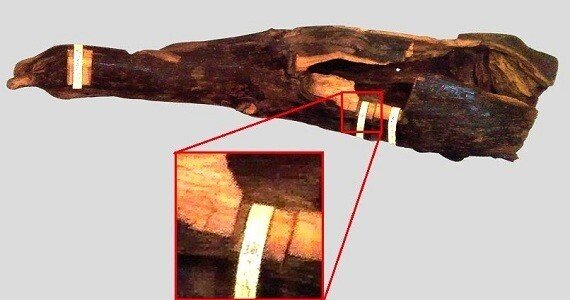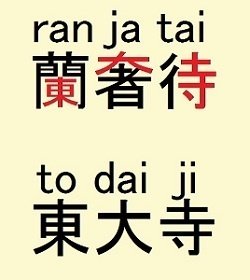
Ranjatai Cutting — Nara, 19 April 1574

Oil on canvas, 45.5×53 cm, 2010-2022, M.Tsushima
Nara has a lot of treasures. Todaiji Temple houses more than 9,000 treasures in the warehouse. Among the treasures is the famous incense wood called Ranjatai, which only supreme rulers in Japanese history were allowed to cut.
Background
In 1568, Nobunaga marched his army to Kyoto to support Ashikaga Yoshiaki to be enthroned to Shogun. Among the warlords who cooperated the campaign was Matsunaga Hisahide who was ruling Nara.
In March 1573, when Yoshiaki broke up with Nobunaga and raised troops, Matsunaga also rebelled against Nobunaga. But just in five months, Yoshiaki was defeated by Nobunaga, and further five months later, Nobunaga's army besieged Matsunaga's Tamon Castle in Nara. Matsunaga surrendered and left the castle.
On 18 April 1574, Nobunaga entered the Tamon Castle with an army of 3,000 strong. The following day, he had the incense wood called Ranjatai brought from Todaiji Temple to the Tamon Castle and cut off two pieces of it.
Accounts
Ota Gyuichi(1527-1613), a samurai who served Nobunaga, writes[1]:
Nobunaga reported to the imperial court his desire to have a piece of Ranjatai incense wood which was kept at the Todaiji Temple, Nara. Then on March 26th, the imperial officers, Hino Terusuke and Asukai Dainagon, thankfully issued an imperial document, then, monks of Todaiji Temple politely accepted the demand. Then the following day, March 27th, Nobunaga came to the Tamon Castle in Nara. The magistrates were Ban Kyurozaemon, Sugaya Kyuuemon, Sakuma Uemon, Shibata Shuri, Niwa Gorozaemon, Hachiya Hyogonokami, Asaki Settunokami, Sekian, Yukan, and Tsudabou. that's all.
On March 28th, around 8 am, they opened the treasure house. The famous incecnse wood was housed in a 1.8 meter cabin. Soon it was carried to the Tamon Castle, where on the stage in the reception hall it was displayed to Nobunaga. In accordance with the rules, a piece of 5.5 cm was cut. Nobunaga told the entourage guards to look at it, since it was to be the story told to their descendants. They saw it, thanks to Nobunaga's power, and to his compassion, It was the lifelong memory; Words cannot express how thankful we are.
Since some years ago when Shogun Ashikaga Yoshimasa owned the piece of the incense wood, many people of Shogun family wanted to own it, but because it is an extraordinary thing, their desires were not satisfied. This time, thanks to the Buddhist god's mercy, Nobunaga owned the treasure which is famous in the world; Nothing is comparable in our country to the honor and the fame.
Jojitsu(1522-1590), a monk of Todaiji Temple, wrote[2]:
Five Seniors and an annual secretary, a total of six people (Ryuken, Sanezumi, Hidemasa, Kunbaku, Jojitsu, Kenyu) in a blue priest's robe, as prosecutors of the Three Storehouse, in front of the warehouse, or on the bridge, guard the warehouse, without entering it.
Those who enter the warehouse are an executive officer of Yakushiin Temple (in a white priest's robe), six priests of Rokudo Temple which houses the Great Buddha, a total of seven people. They, in red garments, entered the warehouse, looking for the incense, and found it.
Looking for the incense wood, they found a incense wood about 120 cm in length on a metal pot in a large chest in the Middle Storehouse. There was a horn of a big deer in the same chest. The whole chest, packed carefully, was carried by palanquin bearers to Tamonyama. The annual secretary, Kunbaku, and the executive officer, from the Temple accompanied the incense. From Nobunaga was sent the Lieutenant Sakuma who accompanied it. Then, Nobunaga sent a messenger to say to the three people from the temple that since it was selfish of him to make them deposit the incense while he received the piece of it, so, he wanted to be given it before the temple priests, therefore, he would go out near the incense. The three people went to the Middle Gate. The emissaries of that time were the two people, the Lieutenant Sakuma and Hachiya. They brought the chest containing the incense wood and placed it at the center of the Fountain House in front of the reception room, and took out the incense wood. Tonshiki, a Buddha sculptor of the temple, in a white priest's robe, bringing a saw, cut off two 3 centimeter square pieces. Nobunaga told the three people from the temple, "One is for the Emperor, and the other is ours." After that, they received the chest containing the incense wood and accompanied by Sakuma returned it into the original warehouse.
Ranjatai and Todaiji Temple
Ranjatai is an incense wood housed in the Shosoin Warehouse of Todaiji Temple, Nara. Length of 156 cm, width of 21.2-42.5 cm, weight of 11.6 kg, it is a type of agarwood in which resin and essential oil are deposited on the trunk of a plant belonging to the genus Aquilaria of the family Thymelaeaceae. It is estimated to have been brought from a mountainous area in the eastern part of the Indochina Peninsula from central Laos to Vietnam, where a special environmental condition makes trees emit resin as a defense reaction against rain, wind, diseases, pests, It takes more than five decades for the resin cured to gradually change its quality to emit fragrance of an agarwood, therefore, an agarwood like Ranjatai is tremendously rare and expensive.

So, why is it mystically named Ranjatai?
It is composed of three characters: Ran, Ja, Tai. Ran is an orchid and Ja is a musk deer. Mixture of orchid flowers and deer musk was one of the most fragrant perfumes.
But the incense is agarwood. Why is it so called?
The three characters, Ran, Ja and Tai, each comprises each of the characters of Todaiji.

According to an anecdote, the incense wood was supposed to be named Todaiji, since it was owned by the founder of Todaiji Temple, Emperor Shomu(701-756). But because it is an incense wood to be burned, it is ominous to name it as the name of the temple. So instead, it is named Ranjatai, containing the characters of Todaiji.
While the official name of the incense wood is Ojukuko which means a yellow ripe incense, the well-known name, Ranjatai, does not reflect its feature, rather it is a sort of wordplay.
As such, the third character Tai does not have to do with agarwood; It means "to wait". So what does it wait?
Nobunaga enters Nara
Despite the Ranjatai's hope of preventing fire on Todaiji Temple, the temple was burned. In 1567, during the war between Matsunaga Hidehisa, samurai who ruled Nara, and Miyoshi triumvirs who controlled Shogunate, Matsunaga attacked Todaiji Temple where Miyoshis' troops were stationed. Most of the buildings, including the Great Buddha Hall, were burned down. But the Ranjatai was not burned; the Shosoin Warehouse was saved from the fire.
Though Matsunaga, after the war, managed to rule Nara, he was not powerful enough to stabilize the central government. That was done by Nobunaga in 1568, when he marched an army of 60,000 to Kyoto and drove Miyoshi triumvirs and their allies out of the center of Japan.
Matsunaga was subjected to Nobunaga and was allowed to keep control of Nara, while in Kyoto, Ashikaga Yoshiaki, whom he supported, was enthroned as Shogun.
The warring situation, however, did not end. In March 1573, Yoshiaki broke up with Nobunaga and raised troops. Matsunaga also rebelled against Nobunaga. But just in five months, Yoshiaki was defeated by Nobunaga, and further five months later, Nobunaga's army besieged Matsunaga's Tamon Castle in Nara. Matsunaga surrendered and left the castle.

On 18 April 1574, Nobunaga entered the Tamon Castle with an army of 3,000 strong. Buddhist temple dignitaries and residents of Nara went out to welcome Nobunaga[3]. Then Nara restored peace. Nobunaga strictly banned his troops from making a camp at Buddhist temples.
Cutting Ranjatai
The following day, 19 April, at 8 AM, the Shosoin Warehouse of the Todaiji Temple was opened. The Ranjatai was discovered in a 1.8 meter cabin. It was brought to the Tamon Castle where Nobunaga with his guards had waited the legendary incense wood to come.

The Tamon Castle had a garden with a fountain to which extended was a small house, in which on the stage in the reception hall the Ranjatai was placed. A Buddha sculptor of the Todaiji Temple in a white priest's robe had two 3 centimeter square pieces cut off with a saw[2]. Nobunaga allowed his guards to look at it, telling them that it was to be the story told to their descendants[1].
It was really a historical event. Only three people in Japanese history were officially allowed to cut it: the shogun Ashikaga Yoshimasa in 1465, Oda Nobunaga in 1574, and the emperor Meiji in 1877.
That enabled Nobunaga establish his influence in Nara. He appointed his vassal, Ban Naomasa, who was one of the magistrates conducting the Ranjatai cutting, as the new military governor of Nara in the following year, 1575. After Naomasa died in the battle at Osaka in 1576, Tsutsui Junkei, samurai warlord from a family having guarded the Kofukuji Temple in Nara, suceeded him. Junkei, serving Nobunaga, attacked rebellious Matsunaga Hisahide in 1577 and ruined the clan. Then Nara was totally secured.
The impact of Ranjatai cutting was not only in Nara. Nobunaga donated one of the two pieces he cut to the emperor Ogimachi in Kyoto, though Nobunaga might just follow the precedent that the shogun Ashikaga Yoshimasa in 1465 cut two pieces of the Ranjatai and donated one of them to the emperor Go-Tsuchimikado[4].
As for the other piece of the Ranjatai he cut out, Nobunaga cut a sliver of it to give it to his retainer, Murai Sadakatsu, who as the Kyoto deputy played an important role in policing Kyoto, making negotiations with the imperial court, nobles and Buddhist temples.
The other parts of the Ranjatai piece were used at the tea party Nobunaga held at the Shokokuji Temple in Kyoto on 3 May 1574, when he showed it off to merchants from Sakai and gave pieces of it to Tsuda Sogyu and Sen Rikyu, two important council members of Sakai city[5].
Thus, Nobunaga used the Ranjatai pieces to gain his power in Kyoto and Sakai, two important political and strategic bases to conquer Osaka, where his arch enemy, Honganji Temple, took fire against Nobunaga's troops. The strong Osaka Honganji Temple fortress was about to be besieged, when, what Nobunaga really had to cut were communications to Osaka from its allied warlords.
References
[1] 信長公記, 太田牛一
[2] 天正二年載香記, 浄実 (続々群書類従 巻16 p.53)
[3] 多聞院日記. 第2巻, 多聞院英俊 天正2年3月27日 p.167/250
[4] 東大寺三倉開封勘例 (続々群書類従 巻16)
[5] 津田宗及茶湯日記 他会記
Nobunaga On Canvas https://nobunagaoncanvas.blogspot.com/2022/04/ranjatai-cutting-nara-19-april-1574.html
